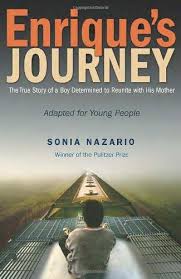
Enrique’s Journey: The True Story of a Boy Determined to Reunite with His Mother
Written by Sonia Nazario. (Adapted for Young People)
Ember, 2014, 288 pp.
ISBN: 9780385743280
Nazario, well-known for her Pulitzer-Prize writing as an investigative reporter, has been named one of “40 women who changed the media business in the past 40 years” (Columbia Journalism Review, 2012). She has won many other humanitarian awards for her advocacy work around social issues, including discrimination, drug addiction, Foreign Policy, hunger, and immigration.
The impetus for this story began with a conversation Nazario had with her house cleaner. As Carmen told Nazario about her four children she had left in Guatemala, Nazario wondered “What drove her to travel two thousand miles away from her children, not knowing when or if she would ever see them again?” (p. 2). Then, about a year later, one of Carmen’s sons, Minor, makes his way to her; he tells Nazario about his trip to the U.S. and, in particular, his ride on El Tren De Muerte. Once again, Nazario found herself questioning the conditions that would prompt mothers to leave their children and then children to travel “at all costs, to be with their mothers.” As the child of immigrant parents, she says she “understood the desire for opportunity, for freedom;” but she readily admits, “I had no true understanding of what people are willing to do to get here to have that same opportunity and freedom” (pp. 6-7).
When Nazario began her investigation in 2000, she discovered about 48,000 unaccompanied children annually rode the rails from Central America and Mexico to the United States in search of their mothers. This rate has now more than doubled. The average child is a 15-year-old male. In order to best capture the story, she wanted to find someone who fit this profile, so she “scoped out a dozen shelters and churches along the Mexican side of the border that help migrants, including children” (p. 10). She eventually discovered Enrique, a 17-year-old boy from Honduras. While he was slightly older than the average age, she noted he had an actual chance of reaching his mother, something she keenly wanted to document.
She carefully laid out her plans, well aware she could not truly experience what these children did because, at the end of the day, she could go to a hotel, shower, and eat. However, she hoped in the process, she would be able to accurately tell their story. Ultimately, she spent more than six months traveling from Honduras to the United States, riding atop seven different trains, and then repeated the entire journey to gather additional information.
I cannot do justice to the telling of Enrique’s story in this review; I do not have the ability to capture the senses in the way Nazario does in her writing—a very intentional process; she writes in a way that helps readers experience what Enrique feels, hears, sees, smells, and tastes along his journey. It is an onslaught of the senses, both good and bad that leaves readers reeling.
Nazario describes this adaptation for young people as “aimed at middle school students and reluctant readers in high school. It was a 2014 Notable Social Studies Trade Books for Young People award winner, was listed as a Best Teen Book of the Year by Kirkus, and was a Junior Library Guild Selection. This adaptation also includes an 8-page photo spread of Enrique and his family and contains an update on them since the writing of the adult edition.
Books that might be read alongside Enrique’s Journey are: A Long Walk to Water: Based on a True Story by Linda Sue Park (2010), Inside Out and Back Again by Thanhha Lai (2010), Hidden Girl: The True Story of a Modern-Day Child Slave by Shyima Hall (2015), Denied, Detained, Deported: Stories from the Dark Side of Immigration by Ann Bausum (2009), and Remix: Conversations with Immigrant Teenagers by Marnina Budhos (2007).
Gail Pritchard, University of Arizona, Tucson, AZ
WOW Review, Volume VII, Issue 4 by Worlds of Words is licensed under a Creative Commons Attribution-NonCommercial-ShareAlike 4.0 International License. Based on work at https://wowlit.org/on-line-publications/review/vii-4/
